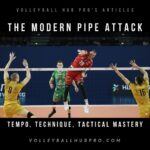Introduction
The attack is the most critical skill in volleyball, representing the ultimate offensive weapon for scoring points. The attack is the primary fundamental responsible for winning matches. While defense and passing lay the foundation, the attack is the finisher.
Mastering proper spiking technique provides hitters with the tools to hit with power, accuracy, and consistency. Developing sound mechanics in footwork, arm swing, body positioning, and other facets of spiking allows hitters to expand their scoring arsenal. However, proper technique must come before adding speed and complex tactics.
This article will break down the key technical elements of spiking that coaches should look for in their team. While advanced skills like off-speed hits and combination plays have their place, every hitter must build on the basics. Proper spiking form is challenging to instill, but pays dividends in match situations. By thoroughly teaching the foundational spiking skills outlined in this piece, coaches can enable their athletes to become potent point scorers.
Footwork and Approach Patterns
Footwork is the foundation of every effective spiker. Before developing power and speed, players must first master proper footwork patterns and fundamentals. A spiker’s approach is the initial step in executing an attack. Coaches should devote significant time to ingraining proper approach footwork to build consistency in their hitters.
The most common approach patterns like the 3-step or 4-step should be repeatedly rehearsed to the point of muscle memory. Coaches must emphasize consistent foot timing, proper angles relative to the setter, and a forceful last two steps. The approach should be adjusted based on the location of the set. For example, middle hits require a direct forward approach, while outsides will generally approach from an angled trajectory. For less experienced players, focus on establishing technically sound footwork before adding full approach speed.
Arm Swing Timing and Rhythm
Proper synchronization between the arm swing and footwork requires endless repetition. Great spiking originates from the ground up. The arm swing is instrumental for generating power and directing the spike with precision. When instructing arm mechanics, coaches must stress the timing of the swing’s phases relative to the steps of the approach. The arms should be fully loaded back during the penultimate step, with the forward swing progressing for a high contact point slightly in front of the hitter’s shoulder. Cues like “left-right-boom!” help players time their swing. Beginners may need to approach slowly, focusing solely on the arm motions until timing improves. Developing seamless rhythm between the footwork and arm swing is crucial for fluid, effective spiking.
High Contact Point
Elevating the hands on the approach raises the hitter’s center of gravity for greater lift on the spike. Often overlooked by beginners, contacting the ball at the apex of the reach is essential for maximizing spike power and downward trajectory. Players should fully extend their arm swing upward, with the goal of contacting the ball 12-18 inches above the height of the net at the peak of their vertical leap.
This lofty contact point allows spikers to redirect downward momentum from their approach into the spike for a powerful straight attack. Coaches can use visual cues like placing a target contact point mark on the wall during practice to provide feedback. Players should actively engage their core muscles when contacting the ball to prevent their hitting shoulder from dropping.
Arm Speed and Strength
Once proper technique is ingrained, developing arm speed and strength is vital for generating spike power. Medicine ball overhead throw drills, resistance band training, and weighted ball swing drills can help build arm and shoulder strength. Plyometric push-up variations and lateral box jump drills also help train explosive arm speed and power.
However, coaches must remind players not to sacrifice proper form in pursuit of strength gains. Implementing targeted exercises into training will allow athletes to swing faster during an approach and make more forceful contact at the peak reach. A strong arm swing means little without precise timing and mechanics.
Body Positioning and Rotation
Proper alignment and powerful rotation of the body mid-air are critical for keeping spike attempts in bounds and aimed correctly. On the approach, coaches should watch for rotated shoulder alignment toward the setter rather than perpendicular to the net.
At the moment of contact, the hitter’s shoulders and hips should be turned slightly in the direction of the intended spike angle, with the shoulders ahead of the hips. Rotating the core muscles to “open up” the hips and shoulders mid-flight is key. Cues like “turn your jersey to the court” help facilitate this essential body rotation.
Faults like dropping the hitting shoulder or landing off-balance can be corrected by slowing down the approach and rehearsing the motions without a full jump. Rotating the core and upper body explosively into the ball transfers energy from the legs into the arm swing.
Follow Through
The follow-through after ball contact is often neglected by players but should not be overlooked. Coaches must ingrain the habit of continuing the arm swing downward and across the body after spiking the ball. The arm should finish across the opposite side of the hitter’s torso, with the thumb pointing down towards the floor.
This full follow-through promotes proper body rotation during the swing and prevents the common mistake of stopping the arm motion abruptly upon contact. Players should hold their landing and finish with control for a brief moment following the swing. Developing full, intentional follow-through requires considerable practice and feedback from coaches.
Conclusion
By thoroughly teaching the fundamental components of spiking technique – footwork, arm swing, high contact point, body positioning, and follow-through – coaches can establish proper mechanics in their athletes. Mastering these core skills enables volleyball players to develop into potent, strategic hitters capable of terminating points.
Once these sound fundamentals are concrete, more advanced abilities can be layered on top. Power training, diversifying shot selection, combination plays, and other high-level skills should come after a foundation of correct form is set. Proper technique may be challenging to instill initially, but is crucial for excelling in the attack.
While the tactics of volleyball evolve, the foundational principles of sound spiking remain constant. Coaches who invest significant time into ingraining excellent technique in the attack give their hitters the tools to thrive. By building proper mechanics and then emphasizing strength, speed, and smarts, attackers will gain confidence and consistency in their most crucial skill.
Owning the attack requires dedication to perfecting all aspects of the swing. Coaches must break down the technical details, provide quality feedback, and drill proper form until it becomes second nature. With mastery of the basics, hitters will be equipped to terminate points at the moment of truth.









